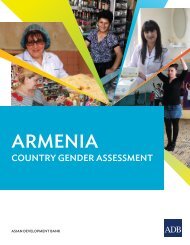Civic Activism as a Novel Component of Armenian Civil Society
English-3
English-3
Create successful ePaper yourself
Turn your PDF publications into a flip-book with our unique Google optimized e-Paper software.
demonstrated that voluntary <strong>as</strong>sociations, among other institutions, shaped participants’ civic<br />
skills and attitudes. Since then, there have been numerous studies <strong>of</strong> the various roles that<br />
<strong>as</strong>sociations play in democratic (Fung 2003; Skocpol 1999; Warren 2001) and not-so-democratic<br />
(Antlöv, Brinkerh<strong>of</strong>f, and Rapp 2010; Beissinger 2005; Geremek 1996b; H<strong>as</strong>hemi 1996)<br />
societies.<br />
<strong>Civil</strong> society studies <strong>of</strong>ten focus on organisations, but there are other players in the civil<br />
society ‘arena’. Not all civil society activities are channelled through formal institutions, nor do<br />
they all take conventional forms. Social movements are also a component <strong>of</strong> civil society,<br />
although their “contentious nature” and <strong>of</strong>ten unconventional repertoire <strong>of</strong> action make them a<br />
specific object <strong>of</strong> research in an ad hoc scientific literature (Della Porta and Diani 1999; Kriesi<br />
1995; Tarrow 1994; Tilly and Tarrow 2007).<br />
Although studies <strong>of</strong> civil society and studies <strong>of</strong> social movements have generally been<br />
advanced through separate schools within social science, there clearly is an area <strong>of</strong> overlap.<br />
Social movements can be seen <strong>as</strong> an “integral component” <strong>of</strong> civil society, or vice versa, the<br />
vibrant <strong>as</strong>sociational life <strong>of</strong> civil society can be seen <strong>as</strong> a part <strong>of</strong> “broader social movement<br />
dynamics” (Della Porta and Diani 2011, 69).<br />
In our study, we examine the interactions (and sometimes elusive borders) between<br />
different forms <strong>of</strong> <strong>as</strong>sociational life within contemporary <strong>Armenian</strong> civil society. Following a<br />
framework proposed by Edwards (2013), we examine the “ecosystem” <strong>of</strong> <strong>Armenian</strong> civil society,<br />
in which two <strong>of</strong> its many elements, NGOs and mini-social movements (in the form <strong>of</strong> civic<br />
activist groups), function and interact with one another.<br />
1.1. <strong>Civic</strong> <strong>Activism</strong><br />
The notions <strong>of</strong> civic activism, civic engagement and civic participation are closely interlinked<br />
with the concept <strong>of</strong> civil society. Specifically, citizen participation in civic activities and events<br />
can be regarded <strong>as</strong> an important feature <strong>of</strong> a well-functioning state because civic actions make it<br />
possible for citizens to achieve common goals in efficient and effective ways (Bellah et al. 2007;<br />
Scheufele and Shah 2000).<br />
Some authors discuss civic activism <strong>as</strong> an element <strong>of</strong> the broader civic and political<br />
culture <strong>of</strong> a given society. The seminal work in this field is that <strong>of</strong> Almond and Verba (1963).<br />
The authors define the concept <strong>of</strong> “civic culture” <strong>as</strong> combination <strong>of</strong> participatory and trustful<br />
attitudes towards the state. This cultural approach is also employed by Inglehart (1997), who<br />
links incre<strong>as</strong>ed citizen participation in m<strong>as</strong>s public activities with the growth <strong>of</strong> post-modernist<br />
values, highlighting that “people power h<strong>as</strong> become an unprecedentedly important factor in<br />
politics” (Inglehart 1997, 212).<br />
In contr<strong>as</strong>t to the above-mentioned authors, Sch<strong>of</strong>er and Fourcade-Gourinch<strong>as</strong> (2001) use<br />
a structural approach to analyse the levels and types <strong>of</strong> civic engagement in various countries,<br />
distinguishing among liberal, non-liberal, corporate and non-corporate states. The authors<br />
conclude that polity characteristics strongly influence not only the levels but also the types <strong>of</strong><br />
10



